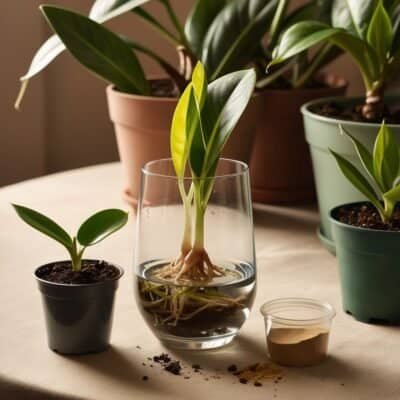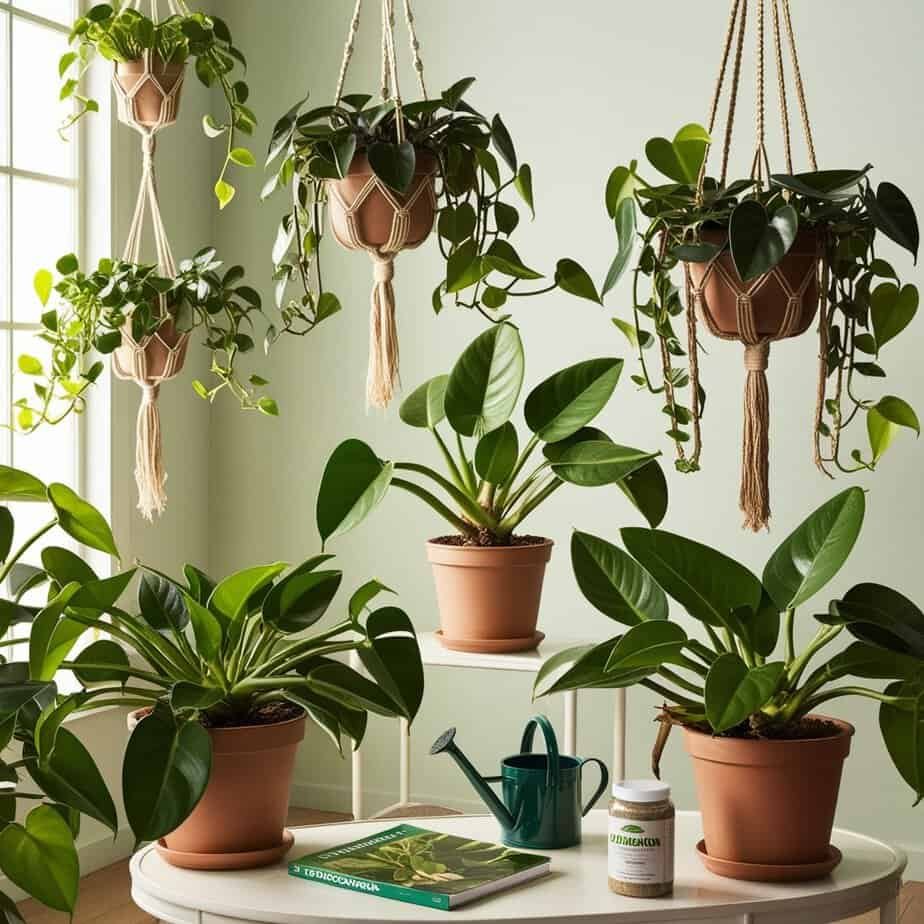Philodendrons are a top choice for indoor plants with their lush green leaves. Known for being both low maintenance and versatile, these tropical beauties can liven up any room. Whether hanging or standing, their leaves grow tall and wide. With some simple care, even novice gardeners can keep their philodendron thriving. Get tips for giving it ideal light, water and fertilizer below. Follow these steps to have a stunning houseplant all year.
Key Takeaway
- Philodendrons thrive in indirect light and prefer high humidity.
- They are low-maintenance and can be easily propagated through stem cuttings.
- Watch for signs like yellowing leaves to prevent common problems.
What is a Philodendron?
Philodendrons come from South America and are part of the Araceae plant family. There are over 450 types of philodendrons and each has its own unique look. Some have heart-shaped leaves while others have large shiny leaves.
Philodendrons can grow different ways. Some types climb and use roots to grab surfaces. Others stand up straight and tall [1]. This variety means they fit many spaces in homes.
People love philodendrons as houseplants because they are easy to care for. They adjust to different light and do well for beginners. Whether you want a small desk plant or larger living room plant, there is a philodendron. Their good looks and flexibility make them popular with plant lovers.
Caring for Your Philodendron
Philodendrons are low-maintenance plants that don’t need much fuss. They do best with indirect sunlight. While they can tolerate low light, philodendrons really shine in bright, filtered sunlight near a window, not direct sun which can burn leaves.
Watering is important too. Keep the soil evenly moist but not soggy. Overwatering can cause root rot, a big problem. Let the top layer of soil dry out before watering again.
Check on your plant regularly. If leaves droop or yellow, it may need more or less water. With a little attention, your philodendron will thrive and bring nature indoors. Proper light and water are the keys to a happy, healthy plant.
Giving Your Philodendron Water and Humidity
Philodendrons love humidity since they’re from tropical places. But indoor air can be dry, especially in winter. To help, mist the leaves with water—this adds moisture to the air around the plant.
You can also put the pot on a tray of pebbles filled with water. As the water evaporates, it raises the humidity for your philodendron. This simple method keeps the plant healthy.
Check soil regularly when watering. Water when the top inch feels dry, usually every 1-2 weeks. Be careful not to overwater or it can harm roots. With the right water and humidity balance, your philodendron will thrive and grow beautifully. Small steps make a big difference for these tropical beauties.
Signs Your Philodendron Needs Care
There are some clear signs when a philodendron needs extra attention. Yellowing leaves usually mean the plant is getting too much water – time to check your watering routine.
Drooping leaves often signal that the philodendron needs a drink – check the soil and water if it’s dry.
Brown tips on leaves can happen if things are too dry or it’s not getting enough nutrients. Try boosting humidity or adding fertilizer if you see this.
Regular checkups help catch issues early. By watching for yellow leaves, drooping, or brown tips, you can keep your plant healthy. Simple care is key to a thriving philodendron.
Common Problems and Solutions for Your Philodendron
Two frequent issues for philodendrons are root rot and pests. Root rot occurs when there’s too much water, so be sure your pot has drainage holes to let excess liquid out.
Spider mites and mealybugs are common plant bugs. If spotted, don’t worry – safely treat with insecticidal soap or neem oil. Both effectively remove pests without hurting the philodendron.
Regular checkups help catch problems early. Taking quick action can keep your plant healthy. With proper care like ensuring drainage and treating pests, your philodendron can overcome challenges and keep thriving beautifully. Addressing issues early means happy houseplants.
Propagating Your Philodendron

Philodendrons are very easy to propagate, making them great for plant parents. The best method uses stem cuttings. Take a 6-inch cutting with a few leaves from a healthy stem. The leaves help the new plant grow strong.
You can root cuttings in water or soil. For water, place the cutting in a clear cup to watch roots emerge. If using soil, make a small hole and gently add the cutting.
Using rooting hormone powder can boost success by encouraging faster root growth. Once roots form, transfer your new plant to a larger pot. With some patience, you’ll have another philodendron to enjoy. Their simple propagation is ideal for growing beautiful houseplants.
Popular Varieties of Philodendrons
Philodendrons come in many beloved varieties. A favorite is the Heartleaf Philodendron with its small, heart-shaped leaves. Easy care and adaptability make it perfect for beginners.
Another standout is the Pink Princess Philodendron known for stunning pink and green variegated leaves. The mix of colors creates a real eye-catcher, making it a collector’s favorite display plant.
Then there’s the Brasil Philodendron with beautiful green and yellow leaves. Each type has its own charm. Whether you prefer classic shapes or bright colors, there’s a philodendron to suit any home. Their versatility is why plant lovers enjoy these tropical beauties.
The Facts on Philodendron Toxicity
It’s important for plant parents to know philodendrons can cause issues if eaten by people or pets. They contain calcium oxalate crystals that can irritate the mouth and throat, leading to discomfort and pain when ingested.
Because of this toxicity, keep philodendrons up high and out of little hands’ and animals’ reach. Accidental consumption may result in mouth irritation, trouble swallowing, or swelling.
If someone or a pet does eat part of a philodendron, medical help should be sought right away. By understanding this risk, you can still safely enjoy your plant’s beauty. Always prioritize safety when caring for these tropical beauties at home.
Philodendrons at Home and Their Natural Habitat
Philodendrons thrive in the warm, moist rainforests they call home [2]. Thriving in low light, they do well indoors where sun can be limited. This adaptability is part of why they make such popular houseplants.
In warmer climates from USDA zones 10-12, philodendrons can enjoy outdoor living too. Here they experience the humidity and conditions similar to their natural environment.
When grown outside, philodendrons climb trees or spread across the ground just as they would in the wild, adding beauty. Whether inside or outside, these tropical plants bring the rainforest indoors. Their flexibility is part of the philodendron’s enduring appeal.
FAQ
What are the best conditions for growing a philodendron?
Philodendrons prefer bright, indirect light and moist, well-draining soil. They can tolerate a wide range of light levels, from low to bright, but thrive in medium to bright light. The soil should be kept consistently damp, but not waterlogged. Philodendrons are generally low-maintenance and fast-growing indoor plants.
How tall do philodendrons typically grow?
Philodendrons come in a variety of sizes, from small, compact varieties that only reach a few feet tall to large, vining types that can grow up to 10 feet tall or more. The “lacy tree” philodendron and “fiddle leaf” philodendron are examples of larger, tree-like varieties that can reach several feet in height.
What are the different philodendron varieties?
Philodendrons come in a diverse range of varieties, from the classic “heart leaf” philodendron to the striking “silver sword” and “ring of fire” types. Some popular varieties include the “golden goddess,” “white princess,” and “‘thai sunrise'” philodendrons, each with their own unique leaf shapes and colors.
How should I care for a philodendron?
Philodendrons are relatively low-maintenance plants. They require moderate, regular watering, keeping the soil consistently damp but not soaked. Misting the leaves with a damp cloth can also help maintain humidity. Philodendrons prefer bright, indirect light but can tolerate lower light conditions. Fertilize during the growing season in spring and summer.
What are common issues with philodendrons?
The most common problems with philodendrons are related to watering and light. Overwatering can lead to root rot and yellowing or browning of the leaves. Underwatering can cause the leaves to droop and the soil to become too dry. Insufficient light can result in the plant becoming leggy and the leaves losing their lush, deep green color.
How do I propagate a philodendron?
Philodendrons can be easily propagated from stem cuttings. Simply take a 4-6 inch cutting with a few leaves and aerial roots, and plant it in moist, well-draining soil or water. Keep the soil or water consistently damp until new growth appears. Philodendrons can also be divided at the root ball to create new plants.
What are the care requirements for philodendrons?
Philodendrons are known for being relatively low-maintenance indoor plants. They require medium to bright, indirect light and consistently moist, well-draining soil. Avoid letting the soil become completely dry or staying waterlogged. Fertilize during the growing season in spring and summer. Prune off any dead or damaged leaves to keep the plant looking its best.
Conclusion
In closing, philodendrons make wonderful houseplants that are easy to care for with a little attention to their needs. Keep an eye on watering, light exposure and humidity levels. With simple care, these rainforest beauties will reward you with lush leaves for years to come. Their beauty, versatility and low demands make philodendrons a great choice for any home. Enjoy your tropical houseguests!
References
- https://leafyplace.com/philodendron-types/
- https://en.wikipedia.org/wiki/Philodendron

